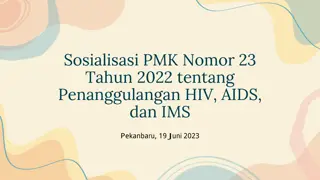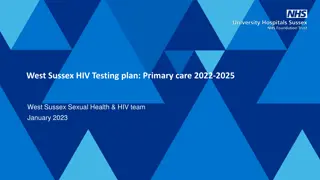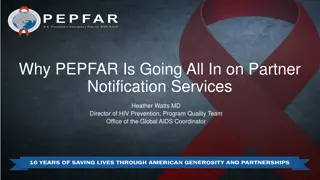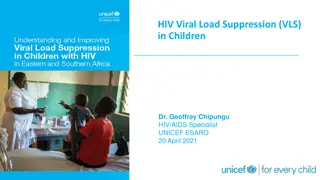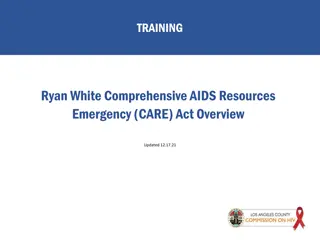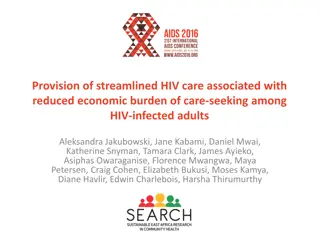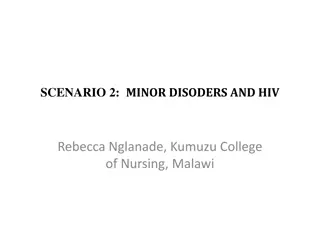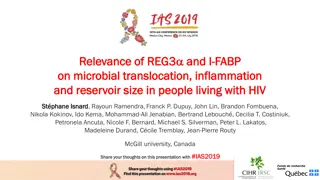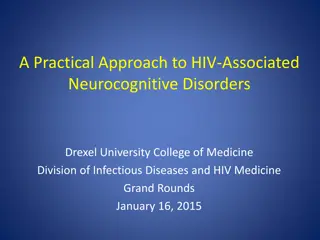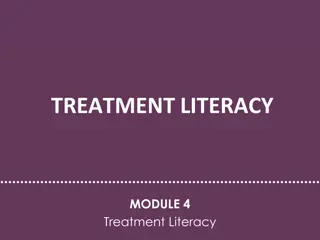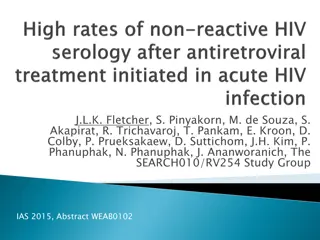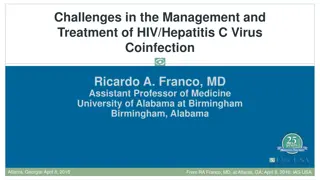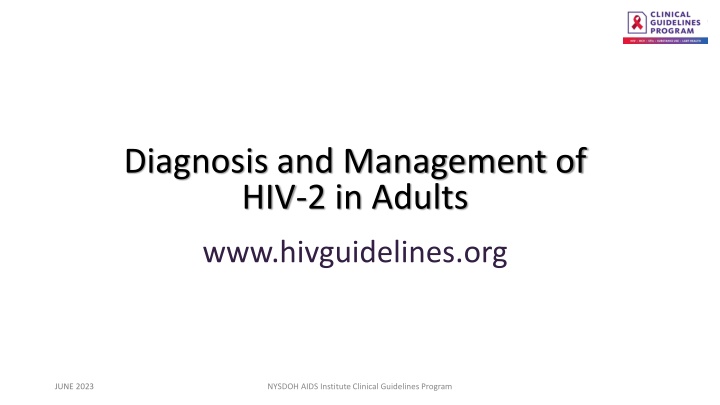
Diagnosis and Management of HIV-2 in Adults
This guideline informs clinicians on diagnosing and managing HIV-2 in adults, including similarities with HIV-1, preferred ARV regimens, and testing recommendations. HIV-2, prevalent in West Africa, progresses slower than HIV-1 with lower transmission efficiency but similar clinical manifestations.
Download Presentation

Please find below an Image/Link to download the presentation.
The content on the website is provided AS IS for your information and personal use only. It may not be sold, licensed, or shared on other websites without obtaining consent from the author. If you encounter any issues during the download, it is possible that the publisher has removed the file from their server.
You are allowed to download the files provided on this website for personal or commercial use, subject to the condition that they are used lawfully. All files are the property of their respective owners.
The content on the website is provided AS IS for your information and personal use only. It may not be sold, licensed, or shared on other websites without obtaining consent from the author.
E N D
Presentation Transcript
Diagnosis and Management of HIV-2 in Adults www.hivguidelines.org JUNE 2023 NYSDOH AIDS Institute Clinical Guidelines Program
Purpose of This Guideline Purpose of This Guideline Inform clinicians about when to suspect and how to diagnose and manage the care of adults with HIV-2. Identify the similarities and differences in treatment for patients with HIV-1 and HIV-2. Recommend preferred ARV regimens for treatment and identify ARVs to avoid. Encourage clinicians to use the services of the NYSDOH Wadsworth Center, the New York State public health laboratory, for testing used in monitoring HIV-2. Integrate current evidence-based clinical recommendations into the healthcare-related implementation strategies of the Ending the Epidemic (ETE) initiative, which seeks to end the AIDS epidemic in New York State. JUNE 2023 NYSDOH AIDS Institute Clinical Guidelines Program www.hivguidelines.org
HIV HIV- -2 2 Endemic in West Africa, with the highest prevalence in Cape Verde, the Ivory Coast, Gambia, Guinea-Bissau, Mali, Mauritania, Nigeria, and Sierra Leone. In the United States, from 2010 to 2017, 327,700 HIV cases were diagnosed: 102 were confirmed HIV-2 infections and 11 were dual HIV-1/HIV-2 infections. Cases predominantly in people from West Africa who were living in the northeast United States and had acquired HIV-2 through heterosexual transmission. Number of cases with HIV-2 was proportionate between males and females. In New York State, from 2010 to 2020, 34,949 HIV cases were diagnosed: 43 had HIV-2 infection, 3 had dual HIV-1/HIV-2 infection, and 25 had probable HIV-2 infection. JUNE 2023 NYSDOH AIDS Institute Clinical Guidelines Program www.hivguidelines.org
HIV HIV- -2 and HIV 2 and HIV- -1 1 HIV-2 is associated with slower disease progression than HIV-1 because of lower plasma viral load levels. Because of lower viral load levels, HIV-2 is transmitted less efficiently than HIV-1 through sexual behavior and from mother to child. As with HIV-1, HIV-2 disease progression correlates with increasing plasma HIV-2 viral load. HIV-2 manifests similar clinical signs, symptoms, and opportunistic infections as HIV-1. JUNE 2023 NYSDOH AIDS Institute Clinical Guidelines Program www.hivguidelines.org
Recommendations: Diagnosis of HIV Recommendations: Diagnosis of HIV- -2 2 To diagnose HIV-2 infection, clinicians should follow the standard HIV laboratory testing algorithm. (A1) In individuals who are confirmed to have HIV-2 antibodies, clinicians should perform a clinical evaluation for HIV-2 infection that is similar in scope to the evaluation of patients with HIV-1. (A1) HIV-2 antibodies are confirmed by a reactive result to an HIV-1/2 Ag/Ab combination immunoassay and a positive result for HIV-2 Abs on an FDA-approved supplemental HIV-1/HIV-2 Ab differentiation immunoassay. JUNE 2023 NYSDOH AIDS Institute Clinical Guidelines Program www.hivguidelines.org
Wadsworth Center Bloodborne Viruses Laboratory Wadsworth Center Bloodborne Viruses Laboratory The Wadsworth Center Bloodborne Viruses Laboratory offers HIV-2 viral load testing, free of charge, for patients and healthcare providers in New York State. To submit a specimen for HIV-2 viral load testing, please contact the Bloodborne Viruses Laboratory at 518-474-2163. Specific services include: Quantitative detection of HIV-2 RNA in plasma samples for baseline and subsequent monitoring of response to antiretroviral therapy in patients with confirmed HIV-2 infection. HIV-2 RNA viral load testing during pregnancy. Contact the lab at 518-474-2163 early in the patient s pregnancy to discuss the protocol and timing for testing. HIV testing for all newborns exposed to HIV (HIV-1 and HIV-2) in New York State, free of charge. If a sample is reactive for HIV-2 antibodies, Pediatric HIV Testing (518-486- 9605) will perform a reverse transcription polymerase chain reaction test for qualitative detection of HIV-2 RNA. HIV-2 phenotypic and genotypic resistance testing is not offered at the Wadsworth Center or commercially available in the United States. JUNE 2023 NYSDOH AIDS Institute Clinical Guidelines Program www.hivguidelines.org
Recommendations: Treatment of HIV Recommendations: Treatment of HIV- -2 2 Clinicians should recommend ART for all individuals diagnosed with HIV-2. (A2 ) Before initiating ART in patients with HIV-2, clinicians should perform all of the standard laboratory testing recommended for patients with HIV-1 except for HIV drug resistance testing, which is not available. (A3) Testing includes CD4 count, HIV-2 viral load, creatinine clearance, and status of coinfections such as hepatitis B and C viruses and tuberculosis. Clinicians should not prescribe any NNRTI for the treatment of HIV-2 infection. (A*) Clinicians should recommend a single-tablet regimen that includes 2 NRTIs plus an INSTI as the initial treatment for adults with HIV-2 who are not pregnant and not planning to become pregnant, including those with acute HIV-2 infection. (A2) For individuals with HIV-1/HIV-2 coinfection, clinicians should: Perform HIV-1 drug resistance testing to guide the choice of an initial regimen or to modify a regimen if virologic failure develops. (A2) Recommend an ART regimen that will suppress both viruses effectively. (A*) JUNE 2023 NYSDOH AIDS Institute Clinical Guidelines Program www.hivguidelines.org
Preferred ART Regimens for Initial Treatment of Preferred ART Regimens for Initial Treatment of Nonpregnant Adults With HIV Nonpregnant Adults With HIV- -2 2 Regimen Comments Rating Available as a Single-Tablet Formulation Initiate only in patients confirmed to be negative for HLA-B*5701, including when a rapid-start or test-and-treat initiation of ART occurs before baseline laboratory test results are available. Initiate only in patients with CrCl 30 mL/min. Consider underlying risk of coronary heart disease. Documented DTG resistance after initiation in treatment-naive patients is rare. Mg- or Al-containing antacids may be taken 2 hours before or 6 hours after DTG; Ca-containing antacids or iron supplements may be taken simultaneously if taken with food. Initiate only in patients with CrCl 30 mL/min. Contains 25 mg of TAF, unboosted. Mg- or Al-containing antacids may be taken 2 hours before or 6 hours after BIC; Ca-containing antacids or iron supplements may be taken simultaneously if taken with food. Abacavir/lamivudine/dolutegravir (ABC/3TC/DTG; Triumeq) A1 Tenofovir alafenamide/ emtricitabine/bictegravir (TAF 25 mg/FTC/BIC; Biktarvy) A1 JUNE 2023 NYSDOH AIDS Institute Clinical Guidelines Program www.hivguidelines.org
Preferred ART Regimens for Initial Treatment of Preferred ART Regimens for Initial Treatment of Nonpregnant Adults With HIV Nonpregnant Adults With HIV- -2, 2, continued continued Regimen Comments Rating Available as a Multi-Tablet Regimen With Once-Daily Dosing For TAF/FTC, initiate only in patients with CrCl 30 mL/min. Contains 25 mg of TAF, unboosted. For TDF/FTC, initiate only in patients with CrCl 50 mL/min. For TDF/FTC, consider bone mineral density. Documented DTG resistance after initiation in treatment-naive patients is rare. Mg- or Al-containing antacids may be taken 2 hours before or 6 hours after DTG; Ca- containing antacids or iron supplements may be taken simultaneously if taken with food. Tenofovir alafenamide/emtricitabine or tenofovir disoproxil fumarate/ emtricitabine and dolutegravir (TAF 25 mg/FTC or TDF 300 mg/FTC and DTG; Descovy or Truvada and Tivicay) A1 For TAF/FTC, initiate only in patients with CrCl 30 mL/min. Contains 25 mg of TAF, unboosted. For TDF/FTC, initiate only in patients with CrCl 50 mL/min. For TDF/FTC, consider bone mineral density. Administer as TAF/FTC or TDF/FTC once daily and RAL HD 1,200 mg once daily, dosed as two 600 mg HD tablets. To date, no clinical trials have been conducted with TAF and RAL; data are based on bioequivalence pharmacokinetic studies. Mg- or Al-containing antacids are contraindicated; coadministration of Ca- containing antacids is not recommended with RAL HD. Tenofovir alafenamide/emtricitabine or tenofovir disoproxil fumarate/ emtricitabine and raltegravir (TAF 25 mg/FTC or TDF 300 mg/FTC and RAL HD; Descovy or Truvada and Isentress HD) A2 JUNE 2023 NYSDOH AIDS Institute Clinical Guidelines Program www.hivguidelines.org
Alternative ART Regimens for Initial Treatment Alternative ART Regimens for Initial Treatment of Nonpregnant Adults With HIV of Nonpregnant Adults With HIV- -2 2 Regimen Comments Rating Available as a Single-Tablet Formulation Initiate only in patients with CrCl 30 mL/min. Carefully consider drug-drug interactions with COBI. Contains 10 mg TAF, boosted with COBI. Tenofovir alafenamide/ emtricitabine/darunavir/ Cobicistat (TAF 10 mg/FTC/DRV/COBI; Symtuza) B2 Initiate only in patients with CrCl 30 mL/min. Carefully consider drug-drug interactions with COBI. Contains 10 mg of TAF, boosted with COBI. Separate dosing of Al-, Ca-, and Mg-containing antacids by 2 hours, either before or after EVG. Tenofovir alafenamide/ emtricitabine/elvitegravir/ cobicistat (TAF 10 mg/FTC/EVG/COBI; Genvoya) B1 JUNE 2023 NYSDOH AIDS Institute Clinical Guidelines Program www.hivguidelines.org
Alternative ART Regimens for Initial Treatment Alternative ART Regimens for Initial Treatment of Nonpregnant Adults With HIV of Nonpregnant Adults With HIV- -2, 2, continued continued Regimen Comments Rating Available as a Multi-Tablet Regimen With Twice-Daily Dosing For TAF/FTC, initiate only in patients with CrCl 30 mL/min. For TDF/FTC, initiate only in patients with CrCl 50 mL/min. For TDF/FTC, consider bone mineral density. Administer as TAF/FTC or TDF/FTC once daily and RAL 400 mg twice daily. Al- or Mg-containing antacids are contraindicated; Ca- containing antacids are acceptable with RAL. Tenofovir alafenamide/ emtricitabine or tenofovir disoproxil fumarate/emtricitabine and raltegravir (TAF 25 mg/FTC or TDF 300 mg/FTC and RAL; Descovy or Truvada and Isentress) B3 JUNE 2023 NYSDOH AIDS Institute Clinical Guidelines Program www.hivguidelines.org
Recommendations: Monitoring ART Recommendations: Monitoring ART Clinicians should monitor the virologic and immunologic status of patients with HIV-2 by performing viral load and CD4 count testing at the same intervals recommended for patients with HIV-1. Because HIV-2 viral load testing is available in New York State only through the Wadsworth Center, clinicians who do not have access to Wadsworth Center laboratory testing services should refer patients to practices that do. (A3) Clinicians should continue to monitor CD4 count every 6 months in all patients with HIV-2, even those with persistent viral suppression. (B2) If HIV-2 viral load testing is not available, clinicians should suspect treatment failure if patients experience a sustained decrease in CD4 count, defined as a 30% decrease in CD4 count or a 3-point decrease in CD4%, confirmed by repeat testing (B2), or have clinical disease progression. (A2) If patients with HIV-2 have either virologic or immunologic treatment failure, clinicians should consult with an experienced HIV-2 clinical management specialist. (A3) Contact the NYSDOH Clinical Education Initiative (CEI) Clinician Line, by website or phone: 866- 637-2342, option #3. JUNE 2023 NYSDOH AIDS Institute Clinical Guidelines Program www.hivguidelines.org
Key Points Key Points Treatment of HIV-2 If a PI is being considered as part of an ART regimen for HIV-2 treatment, boosted DRV is preferred. Atazanavir should not be used because of its lack of potency in vitro against HIV-2. Monitoring ART in Individuals With HIV-2 In New York State, the standard of care for individuals with HIV-2 is to initiate and maintain ART to achieve an undetectable HIV-2 viral load. JUNE 2023 NYSDOH AIDS Institute Clinical Guidelines Program www.hivguidelines.org
Recommendations: Management of HIV Recommendations: Management of HIV- -2 in Pregnancy Pregnancy 2 in Clinicians should recommend ART for all pregnant individuals with HIV-2. (A2 ) Clinicians should recommend one of the ART regimens in ART Regimens for Initial Treatment of Pregnant Adults With HIV-2. (A3) Clinicians should not delay ART initiation in pregnant individuals even if there is no or limited access to HIV-2 viral load testing. (A2 ) In selecting an ART regimen for a pregnant individual with HIV-2, clinicians should not include: Boosted ATV, because of its lack of efficacy against HIV-2. (A*) EFV and RPV, the NNRTIs recommended for treatment of HIV-1 during pregnancy, because of a lack of efficacy against HIV-2. (A*) JUNE 2023 NYSDOH AIDS Institute Clinical Guidelines Program www.hivguidelines.org
ART Regimens for Initial Treatment of Pregnant ART Regimens for Initial Treatment of Pregnant Adults With HIV Adults With HIV- -2 2 TextAbacavir/lamivudine (ABC/3TC; Epzicom) if HLA-B*5701 is negative and HBsAg is negative OR Tenofovir alafenamide/emtricitabine (TAF/FTC; Descovy) OR Tenofovir disoproxil fumarate/emtricitabine (TDF/FTC; Truvada) OR Tenofovir disoproxil fumarate/lamivudine (TDF/3TC; multiple brands) AND Dolutegravir (DTG; Tivicay) OR Raltegravir twice daily (RAL; Isentress) OR Ritonavir-boosted darunavir twice daily (DRV/r; Prezista and Norvir) JUNE 2023 NYSDOH AIDS Institute Clinical Guidelines Program www.hivguidelines.org
Recommendation: PEP for HIV Recommendation: PEP for HIV- -2 2 Clinicians should recommend TDF/FTC and RAL as PEP after HIV-2 exposure (3TC may be substituted for FTC). (A2 ) DTG can be used instead of RAL in a PEP regimen. JUNE 2023 NYSDOH AIDS Institute Clinical Guidelines Program www.hivguidelines.org
Need Help? Need Help? NYSDOH AIDS Institute Clinical Guidelines Program www.hivguidelines.org
Access the Guideline Access the Guideline www.hivguidelines.org > Diagnosis and Management of HIV-2 in Adults Also available: Printable pocket guide and PDF NYSDOH AIDS Institute Clinical Guidelines Program www.hivguidelines.org

